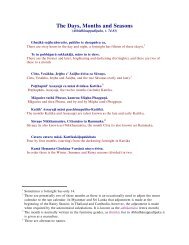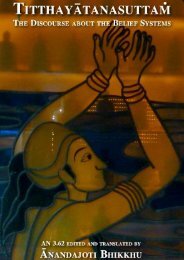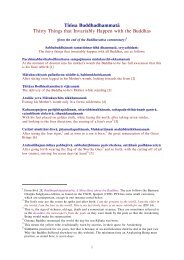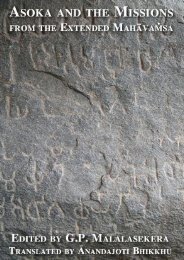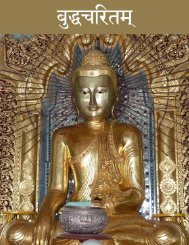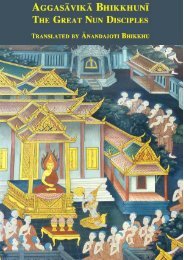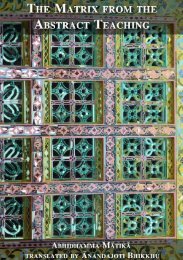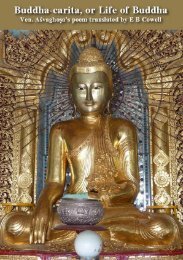MahÄkhandhako The Great Chapter - Ancient Buddhist Texts
MahÄkhandhako The Great Chapter - Ancient Buddhist Texts
MahÄkhandhako The Great Chapter - Ancient Buddhist Texts
Create successful ePaper yourself
Turn your PDF publications into a flip-book with our unique Google optimized e-Paper software.
6<br />
Introduction<br />
<strong>The</strong> text of the first four sections of the <strong>Great</strong> <strong>Chapter</strong> in the Discipline collection 1<br />
traces the life and career of the Buddha for a period of about one year after the<br />
Complete Awakening, and is one of the earliest sources we have for this period in the<br />
Buddha’s life. 2 This section of the text forms a continuous narrative before it is<br />
replaced with a detailing of the various duties incumbent on monastics, and other<br />
rules for the monks and nuns. 3<br />
As the text forms an integral part of the Discipline Collection it appears that it was<br />
originally meant to show how the monastic life was established in the first place, how<br />
and why it evolved, and what is the relationship between lay supporters and<br />
monastics, and only incidentally does it thereby reveal the early part of the Buddha’s<br />
career.<br />
Although many of the discourses that have been preserved provide contextual<br />
information on such matters as where the discourse was given, to whom and for what<br />
reason, very few indeed can be placed within a reliable time frame, 4 and the only<br />
other comparable text we have is <strong>The</strong> Discourse about the <strong>Great</strong> Emancipation<br />
(Mahāparinibbānasutta), which provides a more-or-less continuous narrative detailing<br />
the last year of the Buddha’s life. 5<br />
First Section<br />
Our present text opens some time after the Awakening, 6 with the Buddha still at the<br />
foot of the Bodhi Tree, enjoying the bliss of liberation and reflecting to himself on<br />
Conditional Origination through the three watches of the night. 7<br />
His first encounter with another person only comes when he moves to another tree in<br />
the same area, where he meets someone significantly enquiring about the real<br />
meaning of being a brāhmaṇa. It is here that we see the Buddha for the first time<br />
1 Vinaya Piṭaka, Mahāvagga, Mahākhandhaka, bhāṇavarā 1-4.<br />
2 Other sources include the Mahāvastu, the rescension of which is probably around the same<br />
time as the Pāḷi text, and the Lalitavistara, which, though in the form we have it is<br />
undoubtedly much younger, nevertheless still contains much material that is old and bears<br />
all the signs of authenticity.<br />
3 Even these texts are interspersed with many interesting stories from the life of the Buddha,<br />
which I hope to collect together at some point.<br />
4 <strong>The</strong> commentaries go some way to providing this framework, but their reliability is many<br />
times questionable.<br />
5 A text and translation of this important work was made available last year on this website.<br />
6 According to the much later Introduction (Nidāna) to the Jātaka this would have been about<br />
four weeks after the Awakening, but there are a number of differences between the earlier<br />
and later texts which would make a reconciliation between them difficult, if not impossible,<br />
so we cannot rely on this timing.<br />
7 It may have been the strength of this remembrance that formed the basis for the later<br />
anachronous tradition that the Buddha spent some time in the first few weeks reviewing in<br />
detail all seven books of the Abhidhamma Piṭaka.




